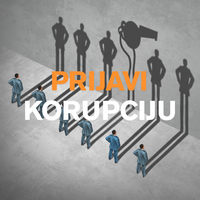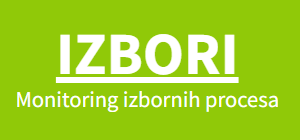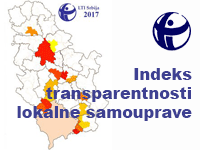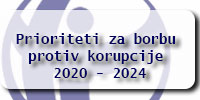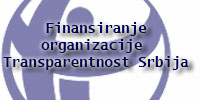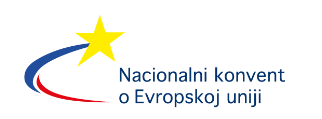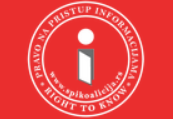On the occasion of the International Anti-Corruption Day: Another missed year
Transparency Serbia, on the occasion of the International Anti-Corruption Day, estimates that Serbia did not use 2017 to substantially improve regulations, strengthen institutions and punish the responsible ones for corruption.
We remind that Serbia is entering the last year of implementation of the National Anti-Corruption Strategy of 2013, which proclaimed the policy of "zero tolerance" for corruption. This act envisioned a multitude of measures to prevent corruption, strengthen all anti-corruption institutions, and increase the number of cases solved. However, many activities have not been carried out even after several "paved" deadlines, and no engagement has been noticed on the implementation of individual measures for the past four years. It is indispensable that the National Assembly has not considered reports of the Anti-Corruption Agency for years on (non) implementation of this strategy, nor calls on the ministers and other managers of state bodies who fail to fulfill their obligations.
Transparency - At the time of its adoption, Serbia considered this Strategy and the accompanying Action Plan as insufficiently ambitious, considering the widespread corruption in the country. Thus, for example, as an indicator of success for the prosecution of corruption, the increase is determined in the number of judgments by 30% in 2017. in regard to the baseline situation in 2012. which was marked as very bad. An additional problem for assessing success is that public prosecutors do not publish statistical data. Citizens receive periodic information about police actions and the arrest of a large number of suspects, where corruption is mixed with other crimes. On the other hand, no state authority provides comparable information on how many of the arrested people are really accused, whether the court confirmed their guilt, let alone what was undertaken in order to avoid a similar case in the future.
During 2017, although it was foreseen by the plan, the laws on the Anti-Corruption Agency, the financing of political activities and free access to information of public importance were not improved. Lobbying has not yet been regulated, nor have rules on public debates in drafting laws been improved. Serbia has not taken any step forward in reducing political influence in the public sector.
On the contrary, directly in contrast to the law, almost all the directors of large public enterprises and the vast majority of top civil servants are in the status of duty-bearers and can be replaced every time by an arbitrary political decision by the ruling parties. In addition, the practice of contracting the largest infrastructure projects with direct agreements has been continued, and based on the interstate agreements and related credit arrangements. Many binding decisions of the Commissioner for Information, which are required to disclose documents, are still not executed, which is contrary to the law. The government itself ignores requests for access to the information that has been sent to it. Additionally, in 2017, the position of independent state bodies deteriorated, because the term of office of the President and members of the Council of the State Audit Institution expired, since three members of the Anti-Corruption Agency Anti-Corruption Board were not nominated, and the director of that agency resigned shortly after.When all this is taken into account, the fact that the fight against corruption is given less importance in the program of the Government of Serbia in 2017 than in previous years is particularly worrying. It is equally bad that Serbia has been insufficiently using The European Integrations as a fighter for combating corruption.In that sense, the year before us is crucial, because the plans for the reform are currently being created until the expected entry of Serbia into the EU in 2025. If the plans are now imprecise and unambitious, we can come to the conclusion that the final assessment of the fulfillment of the conditions for accession is negative or based on the arbitrary criteria.
News
A Year of Concealed Information and False Claims
Serbia marks another International Right to Know Day, while problems in this field remain unresolved. Over the past year, in addition to the denial of important information upon request, numerous cases have been recorded in which public authorities falsely claimed that they did not possess the requested documents. Combined with…
... detaljnije ...Law on Legalization of Buildings – Breach of Rules and Corruption Risks
The announced adoption of the draft law introducing a new framework for the legalization of buildings at tomorrow’s session of the Government of Serbia would constitute a violation of several laws and of the Government’s Rules of Procedure, since no public debate was held and no corruption risk analysis was…
... detaljnije ...With the Constitutional Court remaining silent, EXPO projects continue to be awarded without competition
The Constitutional Court has still not ruled on the initiative submitted by Transparency Serbia to declare unconstitutional a provision of the special “EXPO Law,” which exempts EXPO-related projects from the application of the Law on Public Procurement. Transparency’s latest analysis shows that this inaction has enabled special EXPO companies to…
... detaljnije ...The contract for Prokop is even more harmful than previously thought
New information shows that the illegal contract for the construction of the Belgrade railway station building was even more damaging than it previously seemed The planned procurement of works for the reinforcement of platform beams at Prokop ("Belgrade – Center") [1]shows that the state will bear additional costs in order to…
... detaljnije ...Call for Applications for NGOs to combat corruption with political integrity data in Serbia
In the framework of the regional project “Integrity Watch in the Western Balkans and Turkey: civil society combating corruption with political integrity data”, Transparency Serbia is launching the call for proposals for non-governmental organizations in Serbia to fight political corruption and strengthen integrity in political financing, legislative decision-making, and public…
... detaljnije ...Training and implementing “Local Transparency Index (LTI)” research in North Macedonia and Serbia
With the meeting of the representatives of TI-Macedonia and TI-Serbia held in Belgrade on 11 and 12 June 2025 was marked the beginning of the Peer Exchange Program supported with Transparency International Movement Grant Mechanism financed by the European Union. Transparency Serbia will share its knowledge and experience with TI Macedonia…
... detaljnije ...Inadequate proposal for media services procurement
The proposed amendments to the Law on Public Information and Media will not prevent abuses in the procurement of media services and advertising by the public sector. The provisions on the procurement of media services should be reformulated and clearly written, Transparency Serbia assessed, on the occasion of the debate…
... detaljnije ...Zaječar and Kosjerić – campaign and abuses without control
While the highest officials of Serbia, in meetings with representatives of European institutions, promise to fulfill the key recommendations of the ODIHR, in the campaign for the elections in Zajecar and Kosjerić, the government is working directly contrary to these recommendations, but also to the existing laws. The main reason is…
... detaljnije ...What Hasn't Been Done Prior to the Elections in Zaječar and Kosjerić
There are no new restrictions on officials' campaigns, measures to protect against the misuse of public resources, or fairer rules on campaign financing for the elections in Zaječar and Kosjerić. With the announcement of elections for councillors in Zaječar and Kosjerić,[1] the election campaign began in these two municipalities according to…
... detaljnije ...Entanglement of State and Party Affairs and Absence of Oversight
Contrary to the main recommendation from the June ODIHR report — "measures should be taken to ensure the separation of the state and party and the impartiality of the public administration during the campaign" — Serbia has moved even further away from achieving these goals. This scenario has not been…
... detaljnije ...
Corruption as the main problem of society and priorities for its suppression
Corruption is by far the biggest problem according to citizens (22%), which happened for the first time in 25 years that similar research has been done – according to the survey presented today by Transparency Serbia. At the same time, as many as 41% of citizens believe that it is…
... detaljnije ...Joint Statement - Regional Community of Practice - Skopje Meeting
Kosova Democratic Institute – TI Kosova and Transparency International Secretariat in collaboration with TI Bosnia and Herzegovina, TI Macedonia, Transparency Serbia and TI Türkiye organized a regional meeting with members of Regional Community of Practice (RCP) in Skopje, on 27-28 February 2025. The meeting discussed a wide range of topics…
... detaljnije ...Reaction of the NCEU regarding the harassment of civil society organizations
he National Convention on the European Union (NCEU) condemns the raid by armed members of the Criminal Police Directorate on the premises of five civil society organizations, including NCEU members, without an appropriate court order. We believe this action, carried out under the orders of the Higher Public Prosecutor’s Office…
... detaljnije ...Presentation of the most important global ranking of countries by perception of corruption - CPI
Transparency Serbia invites you to attend the press conference Presentation of the most important global ranking of countries by perception of corruption - CPI: Where is Serbia on the list? On Tuesday, February 11, 2025, starting at 10 a.m., in the Media Center (Terazije 3, room on the second floor) The results of…
... detaljnije ...Serbian President Must Stop Targeting Civil Society Representatives
The National Convention on the European Union (NCEU) strongly condemns the public targeting of Maja Stojanović and Civic Initiatives – coordinator of the Intersectoral Working Group for Freedom of Expression and Media – by the President of the Republic of Serbia. This targeting has resulted in daily threats and intimidation…
... detaljnije ...Key financial data on the reconstruction of the Novi Sad railway station are still unavailable
Although the Government of Serbia, Railway Infrastructure and the Higher Public Prosecutor's Office in Novi Sad made publicly available many documents related to the reconstruction of the Novi Sad railway station, key information about the financial side of the deal is still unavailable. The Government of Serbia published Annex 1 of…
... detaljnije ...New Year and Christmas holidays
Transparency Serbia's Office will be closed from January 1 until January 7. The first working day after the holiday will be Wednesday, January 8 2025.
... detaljnije ...Insufficient results in preventing corruption in the police and within the top executive functions
Of the 24 recommendations for the prevention of corruption related to the police and within the top executive functions, which Serbia received from GRECO in 2022, only one was fulfilled within the first set deadline. One third of the additional deadline of 18 months has already passed, but there has…
... detaljnije ...Published documents on the collapse of the canopy are incomplete
During the 40 days since the tragedy in Novi Sad, state authorities, and primarily the Ministry of Construction, Transport and Infrastructure, have rejected requests from journalists, organizations and individuals to present contracts, projects and information on the supervision of the reconstruction of the railway station, citing the protection of criminal…
... detaljnije ...OSCE Mission to Serbia announces winners of 2024 Person of the Year Award
The OSCE Mission to Serbia awarded the 2024 Person of the Year award to Ivana Stevanović, Executive Director of the Slavko Ćuruvija Foundation, Veran Matić, President of Association of Independent Electronic Media and member of the Permanent Working Group for Safety of Journalists, and Nemanja Nenadić, Program Director of Transparency…
... detaljnije ...
Presentation of prEUgovor Alarm Report on the Progress of Serbia in Cluster 1
The prEUgovor coalition presents its latest Alarm – report on Serbia's progress in implementation of policies in the areas covered by Cluster 1 (Fundamentals), with the focus on political criteria and chapters 23 (Judiciary & Fundamental Rights) and 24 (Justice, Freedom & Security) of the EU accession negotiations. The Report…
... detaljnije ...Presentation of the Local Self-Government Transparency Index - LTI 2024 - The Most Transparent Municipalities and Cities in Serbia
The Embassy of Switzerland in Belgrade - Swiss Agency for Development and Cooperation and Transparency Serbia will present on October 24, 2024 the results of the LTI 2024. TS assessed and ranked the transparency of all 145 municipalities and cities in Serbia based on 95 indicators,. The presentation of the results…
... detaljnije ...PrEUgovor Commentary on the Reform Agenda of Serbia in the "Fundamentals" Area
Coalition prEUgovor regularly monitors the state of affairs and advocates for substantial reforms in Cluster 1 (“Fundamentals”). In its commentary, it shares its impressions of the document - newly adopted Reform Agenda of the Republic of Serbia, in principle and in selected areas it monitors within the Fundamentals. For 21 measures within the section…
... detaljnije ...Missed opportunities for the prevention of corruption within the executive authority and the police
GRECO's assessment that Serbia has fulfilled only one of the 24 recommendations from the fifth round of evaluation in two years calls into question the existence of strategic commitment and will to combat corruption, but also confirms the findings of the TS from the beginning of this year. The lack of…
... detaljnije ...Conference: How to prevent waste of public resources
Transparency Serbia (TS) and the Center for Investigative Journalism of Serbia (CINS) invite you to the conference: How to prevent waste of public resources Belgrade, Tuesday, 9 July 2024, 10.00 – 12.00 Envoy Congress Center, Gospodar Jevremova 47 Agenda: 10.00 – 10.05 Nemanja Nenadić, Program Director, Transparency Serbia 10.05 – 10.10 Milica Šarić, Director…
... detaljnije ...Serbia remains among the countries with limited budget transparency
Serbia ranks 55th out of 125 countries in the Open Budget Index (OBI) with 51 points out of a possible 100, which labels it as the country with "limited budget transparency", according to Transparency Serbia. Progress of five points compared to the previous survey (from 2021) was achieved solely due to…
... detaljnije ...Proposals for the implementation of ODIHR recommendations and improvement of election conditions
Transparency Serbia has used the opportunity to present to representatives of parliamentary parties and the Working Group of the Government of Serbia for Cooperation with ODIHR a number of specific proposals and priorities for improving election conditions, especially regarding the financing of the election campaign and preventing the misuse of…
... detaljnije ...TS submitted proposals to the Assembly for the implementation of recommendations from the ODIHR report
Transparency Serbia submitted to the Serbian Parliament and the Government Working Group for the Improvement of the Electoral Process proposals regarding the implementation of certain recommendations from the Final ODIHR report after the December 2023 elections and unfulfilled recommendations after the previous elections. TS informed the ODIHR Observation Mission, the citizens…
... detaljnije ...Ministry of Interior should publish data on migration of voters that it submitted to Prime Minister
The claim of the Prime Minister in the technical mandate, according to which "everyone can check" in how many cases citizens change their residence, not only does not correspond to the factual situation but is directly opposite to the official answer that Transparency Serbia received from the Ministry of Internal…
... detaljnije ...Corruption prevention in the executive branch - useful GRECO recommendations have not yet been implemented
If Serbia were to implement the recommendations it received in March 2022 from GRECO (Group of Countries for Combating Corruption) – a body established by the Council of Europe – it would significantly improve the mechanisms for combating corruption in the work of the executive. However, very little has been…
... detaljnije ...
- 1
- 2
- 3





